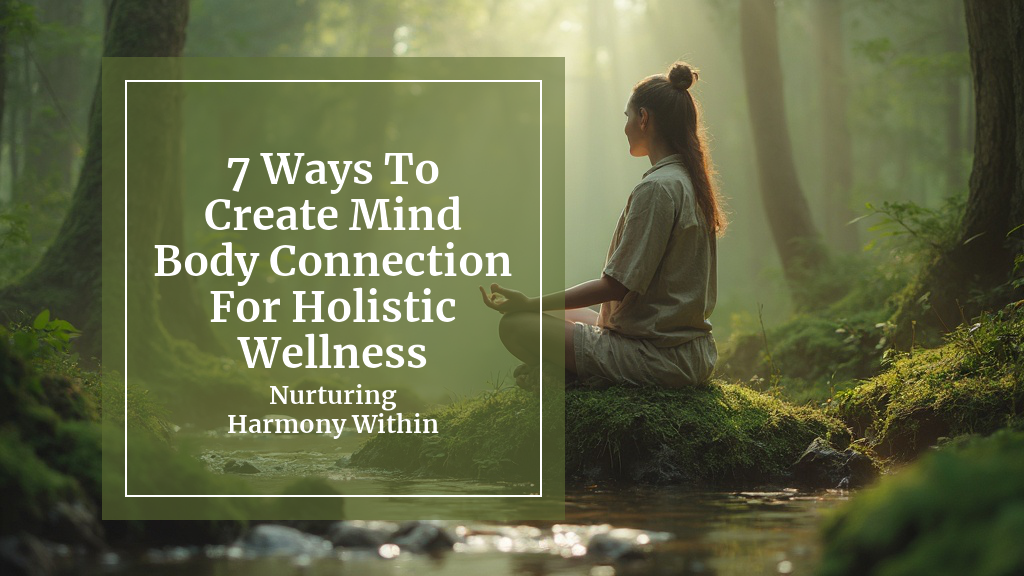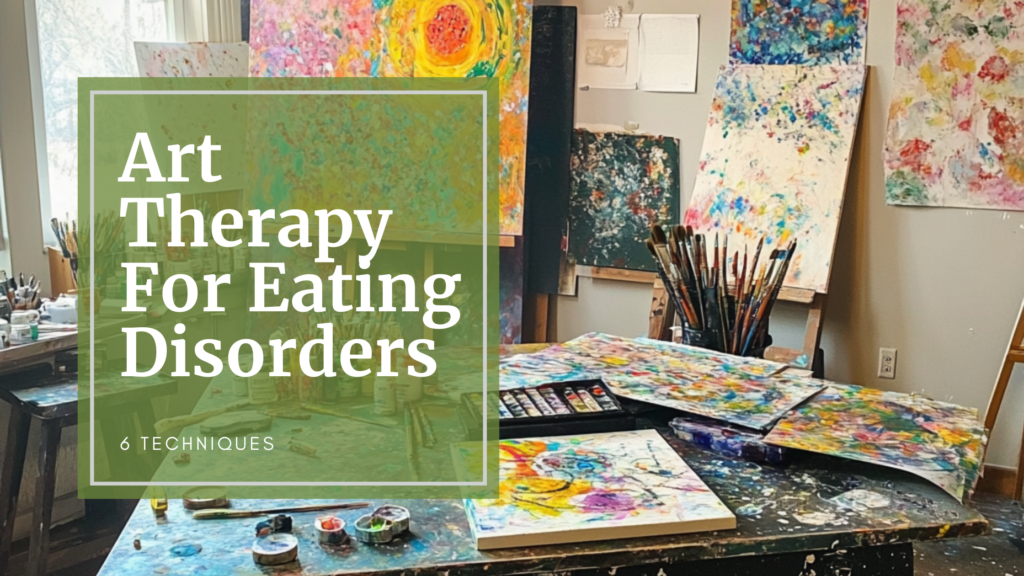7 Ways To Create Mind-Body Connection For Holistic Wellness

Table of Contents
- Introduction
- Mindful Meditation
- Yoga Practice
- Breathwork Techniques
- Body Scan Meditation
- Mindful Eating
- Expressive Arts for Emotional Release
- Connecting with Nature
- Conclusion
Introduction
The mind-body connection is a powerful concept that emphasizes the intricate relationship between our mental and physical states. By nurturing this connection, we can achieve a state of holistic wellness that encompasses both our mental and physical health. This article explores seven effective ways to create and strengthen the mind-body connection, offering practical techniques that can be incorporated into daily life.
Understanding and cultivating the mind-body connection is essential for achieving overall well-being. Research has shown that practices that promote this connection can lead to reduced stress, improved immune function, and enhanced emotional regulation. A study published in PubMed (https://pubmed.ncbi.nlm.nih.gov/28863392/) demonstrated that mindfulness practices significantly reduce physiological markers of stress, including cortisol levels and blood pressure.
As we explore these techniques, it’s important to approach them with an open mind and a willingness to experiment. Each individual may find certain practices more effective than others, so feel free to adapt these methods to suit your personal preferences and needs.
1. Mindful Meditation

Time Required: 10-30 minutes
Materials Needed: Comfortable seating (cushion, chair, or mat)
Mindful meditation is a foundational practice for creating a strong mind-body connection. This technique involves focusing your attention on the present moment, observing your thoughts and sensations without judgment. Regular practice can lead to improved emotional regulation, reduced anxiety, and enhanced overall well-being.
To begin, find a quiet space and comfortable position. Close your eyes and focus on your breath, noticing the sensation of air entering and leaving your body. When thoughts arise, acknowledge them without engaging, and gently return your focus to your breath. Start with short sessions of 5-10 minutes and gradually increase the duration as you become more comfortable with the practice.
Benefits:
- Reduced stress and anxiety
- Improved focus and concentration
- Enhanced emotional regulation
- Better sleep quality
Research from the American Psychological Association (https://www.apa.org/topics/mindfulness/meditation) has shown that mindfulness meditation can be effective in reducing symptoms of anxiety and depression, as well as improving physical health outcomes.
2. Yoga Practice

Time Required: 30-60 minutes
Materials Needed: Yoga mat, comfortable clothing
Yoga is an ancient practice that combines physical postures, breathing techniques, and meditation to create a holistic approach to well-being. By synchronizing movement with breath, yoga helps to strengthen the connection between mind and body, promoting physical flexibility, mental clarity, and emotional balance.
For beginners, start with gentle yoga styles such as Hatha or Restorative yoga. Focus on proper alignment and breathing as you move through the poses. As you progress, you can explore more challenging styles like Vinyasa or Ashtanga yoga.
Benefits:
- Improved flexibility and strength
- Enhanced body awareness
- Reduced stress and tension
- Better posture and balance
The Arthritis Foundation (https://www.arthritis.org/health-wellness/healthy-living/physical-activity/yoga/exercises-to-engage-mind-and-body) recommends yoga as an effective mind-body exercise for individuals with chronic pain conditions, highlighting its benefits for both physical and mental balance.
3. Breathwork Techniques

Time Required: 5-15 minutes
Materials Needed: None
Breathwork techniques are powerful tools for creating a mind-body connection. By consciously controlling our breath, we can influence our autonomic nervous system, reducing stress and promoting relaxation. Various breathwork practices can be used to achieve different effects, from energizing the body to calming the mind.
One simple technique to start with is the 4-7-8 breath:
- Inhale quietly through your nose for 4 counts
- Hold your breath for 7 counts
- Exhale completely through your mouth for 8 counts
- Repeat this cycle for 4 breaths
Benefits:
- Reduced stress and anxiety
- Improved focus and concentration
- Better emotional regulation
- Enhanced lung capacity
A study published in PLOS ONE (https://journals.plos.org/plosone/article?id=10.1371%2Fjournal.pone.0191332) found that breathwork techniques, as part of Mindfulness-Based Stress Reduction programs, can significantly improve psychological functioning in employees, reducing stress sensitivity and symptoms of anxiety and depression.
4. Body Scan Meditation

Time Required: 15-30 minutes
Materials Needed: Comfortable surface to lie on (mat, bed, or floor)
Body scan meditation is a practice that involves systematically focusing your attention on different parts of your body, from your toes to the top of your head. This technique helps increase body awareness, release tension, and promote relaxation.
To practice:
- Lie down in a comfortable position
- Close your eyes and take a few deep breaths
- Begin by focusing on your toes, noticing any sensations
- Slowly move your attention up through your body, pausing at each part
- If you notice any tension, breathe into that area and imagine it releasing
- Continue until you reach the top of your head
Benefits:
- Increased body awareness
- Reduced physical tension
- Improved sleep quality
- Enhanced ability to recognize and address stress in the body
The Holistic Health Practitioner Online Training Course offers in-depth guidance on incorporating body scan meditation and other mind-body practices into a comprehensive approach to wellness.
5. Mindful Eating

Time Required: 15-30 minutes per meal
Materials Needed: A meal or snack
Mindful eating is a practice that involves paying full attention to the experience of eating and drinking. It encourages us to slow down, engage all our senses, and develop a more conscious relationship with food. This practice can help improve digestion, reduce overeating, and enhance our overall enjoyment of meals.
To practice mindful eating:
- Before eating, take a moment to appreciate the appearance and aroma of your food
- Eat slowly, chewing thoroughly and savoring each bite
- Pay attention to the taste, texture, and temperature of the food
- Notice how your body feels as you eat, recognizing signals of fullness
- Avoid distractions like TV or phones during meals
Benefits:
- Improved digestion
- Better portion control
- Enhanced enjoyment of food
- Increased awareness of hunger and fullness cues
A balanced diet plays a crucial role in supporting brain health and overall well-being. Research discussed in Medical News Today (https://www.medicalnewstoday.com/articles/a-balanced-diet-is-better-than-a-vegetarian-one-in-supporting-brain-health) suggests that a diet rich in fruits, vegetables, whole grains, lean protein, and healthy fats can contribute to better mental health and cognitive functioning.
6. Expressive Arts for Emotional Release

Time Required: 30-60 minutes
Materials Needed: Art supplies (paint, paper, clay), journal, or open space for movement
Expressive arts, such as painting, dancing, or creative writing, offer powerful ways to connect with our emotions and release them through creative expression. These activities can help process complex feelings, reduce stress, and promote emotional well-being.
To incorporate expressive arts into your routine:
- Choose an art form that resonates with you (e.g., painting, dance, writing)
- Set aside dedicated time for your practice
- Allow yourself to create freely without judgment
- Focus on the process rather than the outcome
- Reflect on how the activity made you feel afterward
Benefits:
- Emotional release and stress reduction
- Improved self-awareness
- Enhanced creativity
- Better emotional regulation
The Creative Healing Techniques blog offers additional insights into how expressive arts can be used as powerful tools for emotional healing and personal growth.
7. Connecting with Nature

Time Required: 30-60 minutes
Materials Needed: Access to a natural environment (park, forest, beach)
Spending time in nature can have profound effects on our mental and physical well-being. Nature connection practices help us slow down, engage our senses, and reconnect with the natural world around us. This can lead to reduced stress, improved mood, and enhanced overall health.
To practice nature connection:
- Find a natural setting (park, forest, beach)
- Engage all your senses – notice sights, sounds, smells, and textures
- Practice mindful walking, paying attention to each step
- Sit quietly and observe the natural world around you
- Try forest bathing, a Japanese practice of immersing oneself in nature
Benefits:
- Reduced stress and anxiety
- Improved mood and mental clarity
- Enhanced immune function
- Increased feelings of connection and well-being
Research in psychoneuroimmunology, as discussed in The Scientist (https://www.the-scientist.com/psychoneuroimmunology-finds-acceptance-as-science-adds-evidence-57912), supports the idea that our mental states and exposure to nature can significantly impact our physical health, including immune function.
Conclusion
Creating a strong mind-body connection is essential for achieving holistic wellness. By incorporating these seven practices into your daily routine, you can enhance your overall well-being, reduce stress, and improve both mental and physical health. Remember that consistency is key, and it’s important to find practices that resonate with you personally.
As you explore these techniques, consider deepening your understanding of holistic health practices. The Introduction To Holistic Health course offers valuable insights into integrating these practices into a comprehensive approach to wellness.
By nurturing the mind-body connection, you’re taking an important step towards a more balanced, healthier life. Start small, be patient with yourself, and enjoy the journey of self-discovery and improved well-being.
Explore More
- Benefits Of Detoxing With Ayurveda
- Why Choose An Accredited Holistic Practitioner Online Course
- How To Make The Most Of Holistic Online Course
References
- https://pubmed.ncbi.nlm.nih.gov/28863392/
- https://www.apa.org/topics/mindfulness/meditation
- https://journals.plos.org/plosone/article?id=10.1371%2Fjournal.pone.0191332
- https://www.medicalnewstoday.com/articles/a-balanced-diet-is-better-than-a-vegetarian-one-in-supporting-brain-health
- https://www.arthritis.org/health-wellness/healthy-living/physical-activity/yoga/exercises-to-engage-mind-and-body
- https://www.the-scientist.com/psychoneuroimmunology-finds-acceptance-as-science-adds-evidence-57912










Responses